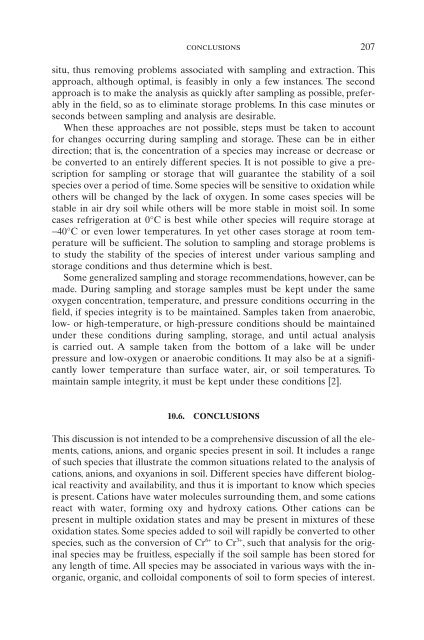Introduction to Soil Chemistry
Introduction to Soil Chemistry
Introduction to Soil Chemistry
You also want an ePaper? Increase the reach of your titles
YUMPU automatically turns print PDFs into web optimized ePapers that Google loves.
conclusions 207<br />
situ, thus removing problems associated with sampling and extraction. This<br />
approach, although optimal, is feasibly in only a few instances. The second<br />
approach is <strong>to</strong> make the analysis as quickly after sampling as possible, preferably<br />
in the field, so as <strong>to</strong> eliminate s<strong>to</strong>rage problems. In this case minutes or<br />
seconds between sampling and analysis are desirable.<br />
When these approaches are not possible, steps must be taken <strong>to</strong> account<br />
for changes occurring during sampling and s<strong>to</strong>rage. These can be in either<br />
direction; that is, the concentration of a species may increase or decrease or<br />
be converted <strong>to</strong> an entirely different species. It is not possible <strong>to</strong> give a prescription<br />
for sampling or s<strong>to</strong>rage that will guarantee the stability of a soil<br />
species over a period of time. Some species will be sensitive <strong>to</strong> oxidation while<br />
others will be changed by the lack of oxygen. In some cases species will be<br />
stable in air dry soil while others will be more stable in moist soil. In some<br />
cases refrigeration at 0°C is best while other species will require s<strong>to</strong>rage at<br />
-40°C or even lower temperatures. In yet other cases s<strong>to</strong>rage at room temperature<br />
will be sufficient. The solution <strong>to</strong> sampling and s<strong>to</strong>rage problems is<br />
<strong>to</strong> study the stability of the species of interest under various sampling and<br />
s<strong>to</strong>rage conditions and thus determine which is best.<br />
Some generalized sampling and s<strong>to</strong>rage recommendations, however, can be<br />
made. During sampling and s<strong>to</strong>rage samples must be kept under the same<br />
oxygen concentration, temperature, and pressure conditions occurring in the<br />
field, if species integrity is <strong>to</strong> be maintained. Samples taken from anaerobic,<br />
low- or high-temperature, or high-pressure conditions should be maintained<br />
under these conditions during sampling, s<strong>to</strong>rage, and until actual analysis<br />
is carried out. A sample taken from the bot<strong>to</strong>m of a lake will be under<br />
pressure and low-oxygen or anaerobic conditions. It may also be at a significantly<br />
lower temperature than surface water, air, or soil temperatures. To<br />
maintain sample integrity, it must be kept under these conditions [2].<br />
10.6. CONCLUSIONS<br />
This discussion is not intended <strong>to</strong> be a comprehensive discussion of all the elements,<br />
cations, anions, and organic species present in soil. It includes a range<br />
of such species that illustrate the common situations related <strong>to</strong> the analysis of<br />
cations, anions, and oxyanions in soil. Different species have different biological<br />
reactivity and availability, and thus it is important <strong>to</strong> know which species<br />
is present. Cations have water molecules surrounding them, and some cations<br />
react with water, forming oxy and hydroxy cations. Other cations can be<br />
present in multiple oxidation states and may be present in mixtures of these<br />
oxidation states. Some species added <strong>to</strong> soil will rapidly be converted <strong>to</strong> other<br />
species, such as the conversion of Cr 6+ <strong>to</strong> Cr 3+ , such that analysis for the original<br />
species may be fruitless, especially if the soil sample has been s<strong>to</strong>red for<br />
any length of time. All species may be associated in various ways with the inorganic,<br />
organic, and colloidal components of soil <strong>to</strong> form species of interest.
















